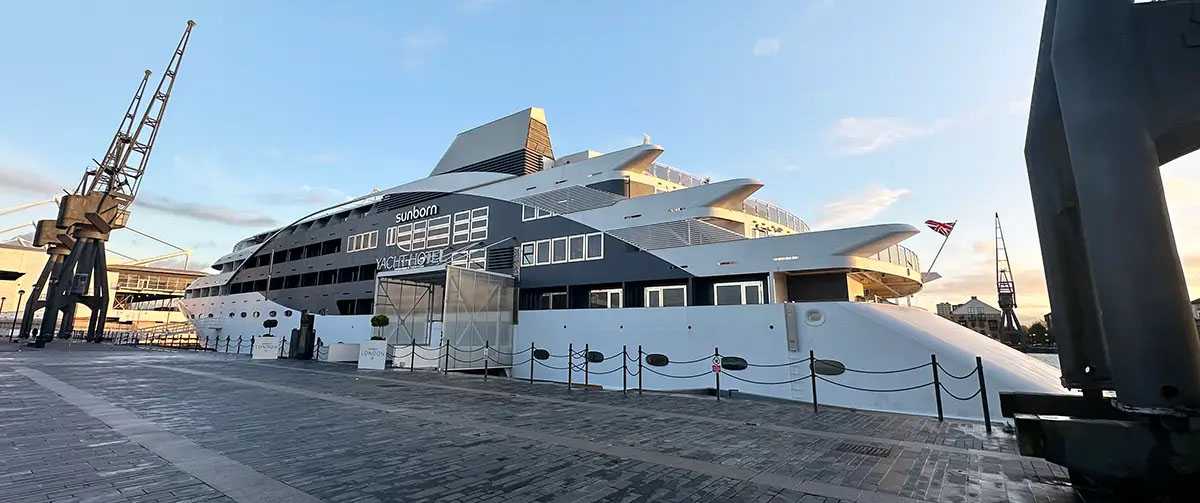Sunborn Yacht Hotel futureproofs with Symetrix
- Details

Originally dropping anchor in 2003, the hotel was upgraded to a second-generation vessel in 2016 with more rooms and events spaces, and even more flexible requirements.
“The boat was still using its original audio system and was only partially operating as a network,” says Tiago. “It was a digital system made up of a mixture of different technologies and manufacturers. It used a central processor with a number of linked amplifiers, while some areas would use local amplifiers to provide connectivity to local sources and some volume control.”
Network documentation was all in Finnish and the only person who understood how the system worked had retired. Not only that, but replacing many of the fixtures was not an option.
“The boat’s speakers are custom finished for the boat, gold plated to match the décor,” says Tiago. “It meant that we needed to keep the speakers, so our first challenge was to work out how the distribution was done and how to run cabling for the new system. We also had to use the existing rack which was located on the bottom deck, because it’s part of the structure of the boat. All our initial considerations were how to design a workable solution within these limitations.”
Each of the six decks had multiple zones to address, and working around the existing infrastructure was not the only challenge. The yacht contains several flexible spaces, with some zones working in conjunction with neighbouring spaces depending on the use case.
“All the ship’s corridors all have multiple speakers,” adds Tiago. “There is a restaurant area and three conference rooms which can combine to become much bigger spaces; they can even be combined with the restaurant.
“So any wall controls that we install in each of these space have an option to combine in different ways, and whatever the source they use can play out in multiple zones. There are additional speakers in the reception area, which is where all the main controllers and the paging system are located, and behind reception is a bar, which has two input zones, and whatever is playing in the bar also plays on the terrace.”
The challenge was not only to design and install a complete system with wall controllers, background music sources, and a paging system, but also one which could be serviced, managed and maintained by non-technical personnel.
Tiago reports, “We wanted to go to an open-architecture system, so we went with Symetrix as a starting point. The second stage was to ensure the system was expandable in the future, so we went with a full Dante system. Obviously, there are input points for microphones, there are wall controllers for controlling not only the local sources, but also the background music sources that they have.
“On top of that, reception has full control over the entire boat, and a paging system which needed to be connected to the Symetrix system to address fire drill and evacuation requirements. The client was very clear that they wanted a system that would be expandable for features to be installed on a later stage, like Bluetooth wall plates to stream music via a phone, and wireless connectivity for projection systems.”
At the core of the system is the Symetrix Prism 16, fully equipped with 64×64 Dante channels to provide multichannel audio networking over IP. With a standard 1U form factor, the Prism was easily accommodated into the venue’s existing racking, while a range of control options made control of the ship’s multiple zones straightforward and adaptable. Meanwhile, Dante connectivity provided greater scope for compatible third-party equipment to be integrated to further future-proof the installation.
“When it comes to control, we designed a system which made it simple to see what can be selected in each area, along with four selectable background music sources connected on the rack side of the system.
“For local sources, Dante enabled us to use third-party wall plates which featured both mic and line inputs with some mixing capability between them, as well as a priority button which ducks the system sound when someone is speaking. The system interface provides access to all the information on every wall control, including what’s been done with the network and how everything is addressed.”
The control architecture was arranged across multiple switchers; one for control, the other one for the Dante network, with the two ports of the Symetrix processor connected to both; one to the Dante network and the other to its own network to provide control via Prism’s own embedded web server for I/O levels, diagnostics, and its browser-based ARC-WEB interface.
“There is always a balance between device capability and price, but this open-architecture design meant we could design it specifically to the needs of the client,” adds Tiago. “It took two weeks to run the Cat 6 cable for the Dante network and for control, and we needed a fair share of inputs and outputs due to the multiple zones but it all merges to the Prism, and building it on Dante technology future proofs the whole network.”
















